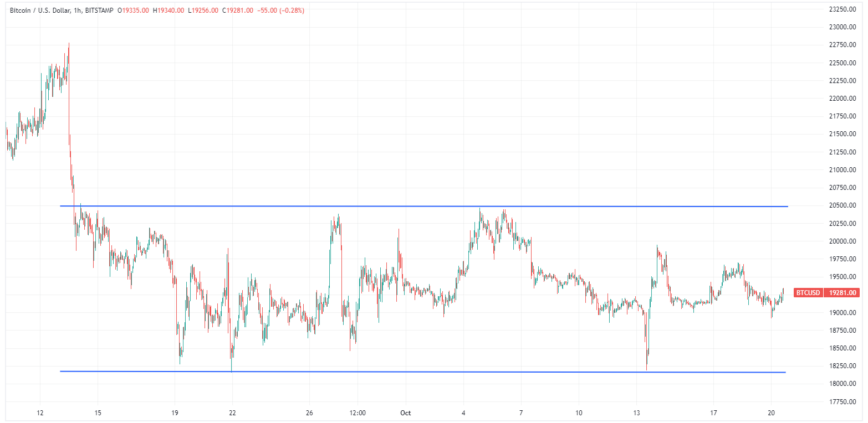Key Takeaways
- A month of narrow trading ranges has some commentators wondering if the bottom is in.
- Looking at recent price action doesn’t tell the whole story, however.
- Comparing the relative trading volumes between the 2018 drawdown and today gives a more comprehensive picture.
Share this article
An unreactive crypto market may signal that prices have found a floor.
Crypto Volatility Drops
After months of downward volatility, the crypto market appears to be stagnating.
Over the past month, the prices of many major crypto assets have remained trapped in an increasingly narrow range. Since September 15, Bitcoin has fluctuated within a tight $2,350 range that appears to be narrowing over time. Ethereum, the second-largest cryptocurrency, has shown a similar drop in volatility, bouncing between the $1,400 and $1,200 levels over the past month.
According to the Crypto Volatility Index (CVI), price movements are at their most subdued since May 7, shortly before the Terra blockchain’s UST stablecoin lost its dollar peg and entered a death spiral, sending shockwaves across the entire market. The CVI currently shows a reading of 65.99, not far off the metric’s all-time low of 50.41, which was set on March 31, 2019.
The effect is so pronounced that Bitcoin has become less volatile than some traditional equities indices. For example, over the past month, Bitcoin has traded within a 9.4% range, as opposed to a range of 10.35% for the NASDAQ100. Additionally, equity volatility, as measured by the S&P Volatility Index, recently registered a new all-time high against Bitmex’s Bitcoin Historical Volatility Index, highlighting the magnitude of the top crypto asset’s drop in volatility.
There are several reasons crypto volatility has plummeted. The most prominent factor is the crypto markets’ lack of trading volume. According to data from Blockchain.com, the total USD trading volume on major Bitcoin exchanges has hit a 30-day average low of $143.5 million, the lowest level since November 2020. When there is less buying and selling of Bitcoin, it often results in more subdued price movements.
However, broader macroeconomic factors are likely also playing a part in Bitcoin’s relative price stability. Uncertainty in global markets has continued to weigh on traditional equities. The Federal Reserve’s monetary tightening policy aimed at reducing inflation has many market participants worried about the…
Click Here to Read the Full Original Article at Analysis Updates – Crypto Briefing…
























